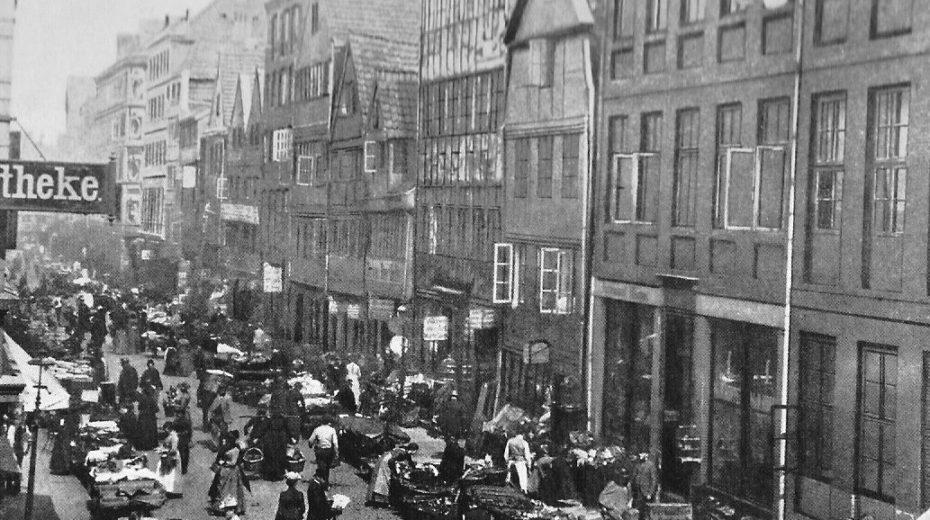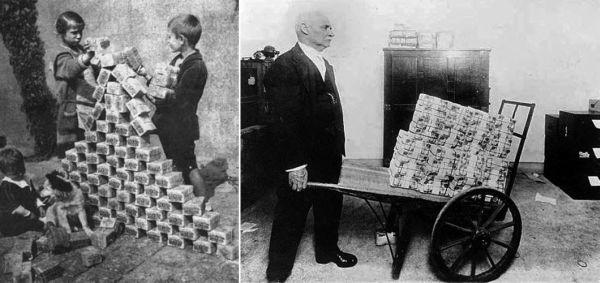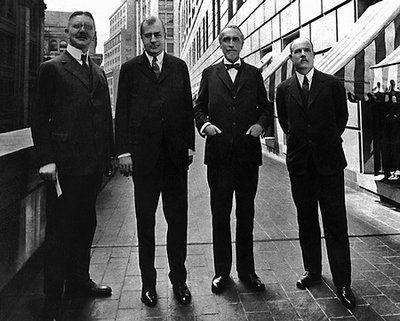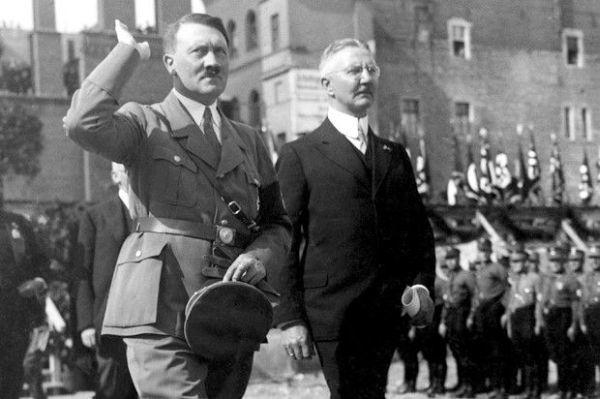
In the past, I discussed why the current financial system is on the verge of a 1923-Weimar style hyperinflation driven by Federal Reserve bailouts trying desperately to support a deleveraging of the $1200 trillion derivatives bubble that has taken over the western banking system. I also discussed the Bank of England-led "solution" currently to this crisis involves a new global "green" digital currency with new "rules" which are very similar to the 1923 Bank of England "solution" to Germany's economic chaos which eventually required a fascist governance mechanism to impose it onto the masses.In this article, I wish to take a deeper look at the causes and effects of Weimar Germany's completely un-necessary collapse into hyperinflation and chaos during the period of 1919-1923.
Versailles and the Destruction of Germany
Britain had been the leading hand behind the orchestration of WWI and the destruction of the potential German-Russian-American-Ottoman alliance that had begun to take form by the late 19th century as foolish Kaiser Wilhelm discovered (though sadly too late) when he said: "the world will be engulfed in the most terrible of wars, the ultimate aim of which is the ruin of Germany. England, France and Russia have conspired for our annihilation… that is the naked truth of the situation which was slowly but surely created by Edward VII".
Just as the British oligarchy managed the war, so too did they organize the reparations conference in France which, among other things, imposed impossible debt repayments upon a defeated Germany and created the League of Nations which was meant to become the instrument for a "post-nation state world order". Lloyd George led the British delegation alongside his assistant Philip Kerr (Lord Lothian), Leo Amery, Lord Robert Cecil and Lord John Maynard Keynes who have a long term agenda to bring about a global dictatorship. All of these figures were members of the newly emerging Round Table Movement, that had taken full control of Britain by ousting Asquith in 1916, and which is at the heart of today's "deep state".

After the 1918 Armistice dismantled Germany's army and navy, the once powerful nation was now forced to pay the impossible sum of 132 billion gold marks to the victors and had to give up territories representing 10% of its population (Alsace-Loraine, Ruhr, and North Silesia) which made up 15% of its arable land, 12% of its livestock, 74% of its iron ore, 63% of its zinc production, and 26% of its coal. Germany also had to give up 8000 locomotives, 225 000 railcars and all of its colonies. It was a field day of modern pillage.
Germany was left with very few options. Taxes were increased and imports were cut entirely while exports were increased. This policy (reminiscent of the IMF austerity techniques in use today) failed entirely as both fell 60%. Germany gave up half of its gold supply and still barely a dent was made in the debt payments. By June 1920 the decision was made to begin a new strategy: increase the printing press. Rather than the "miracle cure" which desperate monetarists foolishly believed it would be, this solution resulted in an asymptotic devaluation of the currency into hyperinflation. From June 2020 to October 1923 the money supply in circulation skyrocketed from 68.1 gold marks to 496.6 quintillion gold marks. In June 1922, 300 marks exchanged $1 US and in November 1923, it took 42 trillion marks to get $1 US! Images are still available of Germans pushing wheel barrows of cash down the street, just to buy a stick of butter and bread (1Kg of Bread sold for $428 billion marks in 1923).

With the currency's loss of value, industrial output fell by 50%, unemployment rose to over 30% and food intake collapsed by over half of pre-war levels. German director Fritz Lang's 1922 film Dr. Mabuse (The Gambler) exposed the insanity of German population's collapse into speculative insanity as those who had the means began betting against the German mark in order to protect themselves thus only helping to collapse the mark from within. This is very reminiscent of those Americans today short selling the US dollar rather than fighting for a systemic solution.
1923: City of London's Solution is imposed
When the hyperinflationary blowout of Germany resulted in total ungovernability of the state, a solution took the form of the Wall Street authored "Dawes Plan" which necessitated the use of a London-trained golem by the name of Hjalmar Schacht. First introduced as Currency Commissioner in November 1923 and soon President of the Reichsbank, Schacht's first act was to visit Bank of England's governor Montagu Norman in London who provided Schacht a blueprint for proceeding with Germany's restructuring. Schacht returned to "solve" the crisis with the very same poison that caused it.

First announcing a new currency called the "rentenmark" set on a fixed value exchanging 1 trillion reichsmarks for 1 new rentenmark, Germans were robbed yet again. This new currency would operate under "new rules" never before seen in Germany's history: Mass privatizations resulted in Anglo-American conglomerates purchasing state enterprises. IG Farben, Thyssen, Union Banking, Brown Brothers Harriman, Standard Oil, JP Morgan and Union Banking took control Germany's finances, mining and industrial interests under the supervision of John Foster Dulles, Montagu Norman, Averill Harriman and other deep state actors. This was famously exposed in the 1961 film Judgement at Nuremburg by Stanley Kramer.
Schacht next cut credit to industries, raised taxes and imposed mass austerity on "useless spending". 390 000 civil servants were fired, unions and collective bargaining was destroyed and wages were slashed by 15%. As one can imagine, this destruction of life after the hell of Versailles was intolerable and civil unrest began to boil over in ways that even the powerful London-Wall Street bankers (and their mercenaries) couldn't control. An enforcer was needed unhindered by the republic's democratic institutions to force Schacht's economics onto the people. An up-and-coming rabble rousing failed painter who had made waves in a Beerhall Putsch on November 8, 1923 was perfect.
One Last Attempt to Save Germany
Though Hitler grew in power over the coming decade of Schachtian economics, one last republican effort was made to prevent Germany from plunging into a fascist hell in the form of the November 1932 election victory of General Kurt von Schleicher as Chancellor of Germany. Schleicher had been a co-architect of Rapallo alongside Rathenau a decade earlier and was a strong proponent of the Friedrich List Society's program of public works and internal improvements promoted by industrialist Wilhelm Lautenbach. The Nazi party's public support collapsed and it found itself bankrupt. Hitler had fallen into depression and was even contemplating suicide when "a legal coup" was unleashed by the Anglo-American elite resulting in Wall Street funds pouring into Nazi coffers.
By January 30, 1933 Hitler gained Chancellorship where he quickly took dictatorial powers under the "state of emergency" caused by the burning of the Reichstag in March 1933. By 1934 the Night of the Long Knives saw General Schleicher and hundreds of other German patriots assassinated and it was only a few years until the City of London-Wall Street Frankenstein monster stormed across the world.
The New Silk Road or New World Order
Today's world sits atop a bubble of unimagined proportions which began to blow in 2008 and has been kept afloat by nothing more than a decade of blind hope mixed with money printing, zero interest rates, speculation and austerity. The PHYSICAL economic basis supporting the money system has been crippled due to 40 years of post-industrial consumerism rampant across the west. While it is admitted that the U.S dollar cannot remain the reserve currency for the world as it has from 1945-present, those same central banking forces from London have admitted that if their plans for a "one-world" green digital currency is not forced onto nations, then China's Yuan and the New Silk Road will shape the new system.
Whether London will manage to succeed in 2020 pushing a fascist de-carbonization (ie: depopulation) scheme onto the world where their 1920 Monster failed remains to be seen.

Commenti
Posta un commento